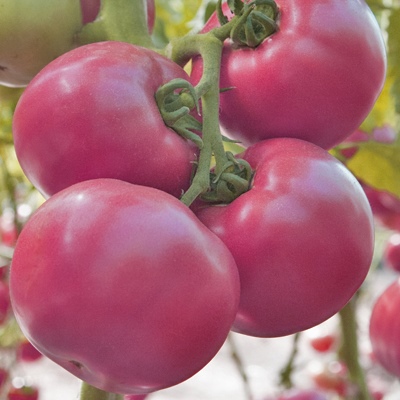
- Year of approval: 2017
- Name synonyms: Pink Samson
- Category: hybrid
- Growth type: indeterminate
- Appointment: fresh consumption
- Ripening period: early
- Ripening time, days: 90-95
- Growing conditions: for greenhouses
- Transportability: Yes
- Bush characteristic: compact, vigorous
Indeterminate hybrids are in great demand among gardeners. Tomato Pink Samson also differs in appearance and taste. That is why it is most often chosen for seedlings.
Breeding history
The originator of the culture is the British company Greenomica, but the variety was developed in Russia. Tomato Pink Samson is registered in the State Register in 2017 and is considered a young hybrid. Also found under another name Pink Samson. Recommended to grow indoors in many regions of Russia.
Description of the variety
Tomato bushes Pink Samson indeterminate, that is, with unlimited growth force. Height can reach 200-220 cm, which is typical for greenhouses. In the open field, the indicators may be lower.
Due to the height of the bush, the stem can break under its own weight and from the weight of the fruit. Therefore, a trellis system or any other garter is thought out in advance.
The barrel is strong and powerful. The crown is spreading. The root system develops extensively and can take root on compacted soils. The variety is not afraid of a short drought due to the roots that penetrate deep into the soil and can search for moisture on their own.
The leaves are large, green. Their peculiarity lies in the fact that they look slightly drooping.
The inflorescence is simple, it is laid between 10-12 leaves. Subsequent - every 3. Buds of a pale yellow shade. 5-7 brushes are formed on one stem, 5-8 fruits are formed on each brush.
Gardeners note that it is best to leave 1-3 stems in order not to overload the bush.
The variety has good taste and appearance.
The main qualities of the fruit
Fruits are flat-round in shape, weighing 240-280 g. As a rule, the largest berries grow on the lower branches. Therefore, at the bottom, the stem is well tied to a peg. The color is unusual, deep pink, in unripe tomatoes it is light green. The skin is thin and glossy, with a slight bloom. There is a slight ribbing that starts at the peduncle and goes to the middle of the fruit. Does not crack, which favorably affects keeping quality and transportability.
The pulp is juicy and firm, slightly watery. Inside, several seed chambers are formed with small empty seeds that are not felt in use.
Taste characteristics
Many gardeners celebrate a versatile taste that will appeal to many.
The variety is suitable for salads and canning. Due to its taste, it is also used in the manufacture of juices, sauces and soups.
Ripening and fruiting
The culture is early maturing. From the formation of ovaries to full ripening of the fruit, an average of 90-95 days pass. Harvesting begins in mid-July and takes place several times.
Yield
Tomato Pink Samson has a yield of 21.3 kg per 1 m2.
The timing of planting seedlings and planting in the ground
Since the variety is quite new, the seeds should only be purchased from a specialized store. Otherwise, you can purchase blank material.
After purchase, the seeds are soaked in warm water for 30 minutes, then treated with a solution of potassium permanganate to disinfect. After the solution, the material is washed again with water and wiped dry.
The earth is poured into the seedling boxes, it is poured abundantly, and only after that the holes are formed.
After the sowing has been done, the soil is irrigated again, and everything is covered with a film. The temperature under the film must be at least +24 degrees. The seeds will sprout within a week.
All top dressing must be applied in liquid form after watering. This is necessary so that young roots do not get burned.
A pick is carried out after the seedlings reach a height of 4 cm, and several strong leaves appear on it.
The new container must have a volume of at least 700 ml. Mixed with the soil, fertilizers can be poured to stimulate growth and wood ash.
It is worth making sure that the seedlings are not damaged by the sun. Since the bushes have unlimited growth force, then at elevated temperatures they will be very elongated. On very hot days, the bushes take cover.
10 days before the new pick, the tomatoes are taken outside for acclimatization. At this time, the site is being prepared. It is dug up and abundantly moistened with water. Pits and a trellis system are formed. At the bottom of the hole, ammonium nitrate can be poured to stimulate stem growth and produce green pigment.
After transplanting, each bush is spilled with warm water, 2 buckets for one seedling. And after that, the procedure is repeated only after a week.

Growing tomato seedlings is an extremely important process, because it largely depends on whether the gardener can harvest at all. All aspects must be taken into account, from seedbed preparation to planting in the ground.
Landing scheme
Gardeners recommend planting tomatoes in a checkerboard pattern with a density of 3 bushes per 1 m2. This will ensure good air circulation. And also the possibility of convenient plant care.

Growing and care
Culture care consists of:
in a standardized watering regime (2 per week);
in regular feeding, liquid fertilizer is applied under the bush every 14 days;
in loosening the soil and removing weeds;
in the formation of a bush;
in the airing of the greenhouse.




A plant needs different micronutrients at each stage of growth. All fertilizers can be divided into two groups: mineral and organic. Folk remedies are often used: iodine, yeast, bird droppings, eggshells.
It is important to observe the rate and period of feeding. This also applies to folk remedies and organic fertilizers.



























































































